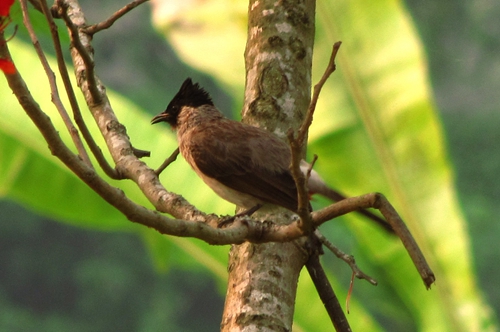Assessing anthropogenic impacts on native ecosystems is an urgent priority for biodiversity conservation. How to measure hunting pressure objectively and efficiently, especially over a network of research sites or reserves, using behavioral information? Flight initiation distance (FID) is the distance between the prey and the predator or hunter at the point when an animal begins to flee. If the prey behaves optimally, one would expect the FID to increase with predation or hunting pressure. Hence, in principle FID may be used to measure hunting pressure in a landscape and use it to compare hunting levels at different sites.
Researchers from Xishuangbanna Tropical Botanical Garden (XTBG) compared FIDs of a common, open-habitat frugivorous bird, Sooty-headed Bulbul (Pycnonotus aurigaster; IUCN Red List Category – Least Concern) , which are targeted by hunters, over an increasing gradient of known hunting pressures in Xishuangbanna Prefecture, Yunnan, SW China. Three field sites of varying hunting pressure were selected for the study: one site is XTBG where birds were not hunted, another site is around Menglun town where there was little to moderate hunting pressure, and the third site is around Mengsong town where hunting pressure was severe.
They carefully controlled for other potential confounding variables, including differences among individuals in their activity levels, perch height and group sizes, both through the sampling design and the statistical analysis.
The researchers found that FIDs were lowest in the botanical garden (XTBG) where there was no hunting. In XTBG, it is possible that there is a confounding effect of habituation as a consequence of the large number of visitors to the garden. However, Menglun and Mengsong had similar human densities, suggesting the much higher hunting in Mengsong was responsible for birds’ higher FIDs there.
As FIDs respond more specifically to hunting than other defaunation metrics, the researchers suggested that the measurement of FIDs can be used as an efficient and replicable method to estimate hunting pressure. FIDs can be used as behavioral indicators of hunting pressure in developing conservation strategies.
The study entitled “Flight initiation distance as behavioral indicator of hunting pressure: a case study of the Sooty-headed Bulbul (Pycnonotus aurigaster) in Xishuangbanna, SW China” has been published in Tropical Conservation Science.

Sooty-headed Bulbul (Pycnonotus aurigaster) at Xishuangbanna Tropical Botanical Garden (XTBG), Yunnan, China;
photo credit: Rachakonda Sreekar

